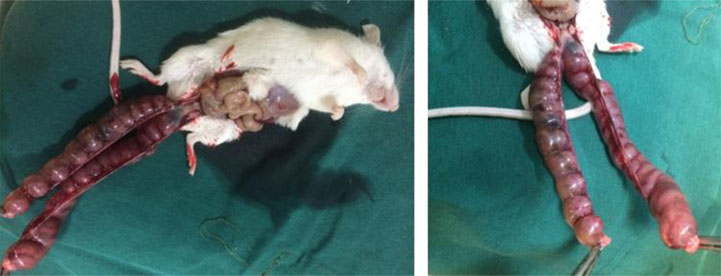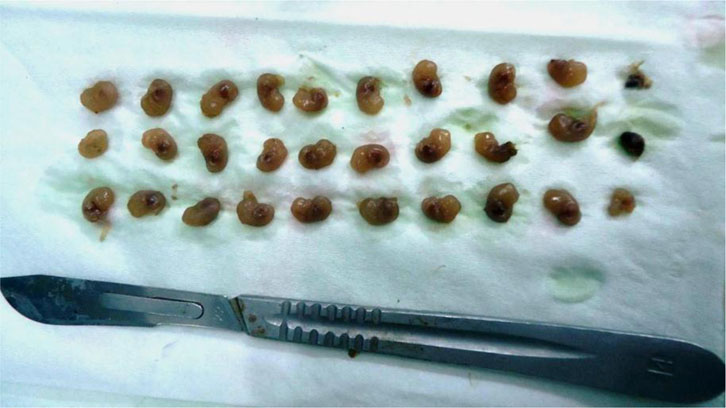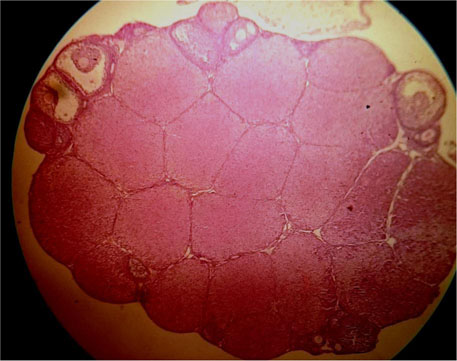Lab Anim Res.
2017 Sep;33(3):280-282. 10.5625/lar.2017.33.3.280.
Super pregnancy in a BALB/c mouse superovulated with PMSG
- Affiliations
-
- 1Department of Clinical sciences, School of Veterinary Medicine, Shiraz University, Shiraz, Iran. mogheiseh@yahoo.com
- 2Gastroenterohepatology Research Center, Shiraz University of Medical Sciences, Shiraz, Iran.
- KMID: 2391103
- DOI: http://doi.org/10.5625/lar.2017.33.3.280
Abstract
- This paper reports a case of super pregnancy in a BALB/c mouse pregnant with 30 pups following induction of superovulation using a PMSG-hCG protocol. Superovulation was induced in 10 mice by injecting 5 IU PMSG followed by 5 IU hCG 48 hours later. Immediately after injection of hCG, animals were placed with males at a ratio of 1 to 1 for 24 hours. On day 14 after mating, animals were killed by cervical dislocation and the uterus was examined for pregnancy and the number of fetuses. The mean (±SEM) number of fetuses observed in ten mice was 5.4±3.18 with an unexpectedly super pregnant mouse bearing 30 fetuses on day 14 of pregnancy.
Keyword
Figure
Reference
-
1. Rugh R. The mouse. Its reproduction and development. Burgess Pub. Co.;1968. p. 225–235.2. Luo C, Zuñiga J, Edison E, Palla S, Dong W, Parker-Thornburg J. Superovulation strategies for 6 commonly used mouse strains. J Am Assoc Lab Anim Sci. 2011; 50(4):471–478.3. EDWARDS RG, FOWLER RE. Fetal mortality in adult mice after superovulation with gonadotrophins. J Exp Zool. 1959; 141:299–322.4. Van der Auwera I, D'Hooghe T. Superovulation of female mice delays embryonic and fetal development. Hum Reprod. 2001; 16(6):1237–1243.5. Sato A. Some observations on induced polyovulation and superpregnancy in mature mice. Embryologia. 1963; 7:285–294.6. Hasegawa A, Mochida K, Inoue H, Noda Y, Endo T, Watanabe G, Ogura A. High-Yield Superovulation in Adult Mice by Anti-Inhibin Serum Treatment Combined with Estrous Cycle Synchronization. Biol Reprod. 2016; 94(1):21.7. Corbin TJ, McCabe JG. Strain variation of immature female rats in response to various superovulatory hormone preparations and routes of administration. Contemp Top Lab Anim Sci. 2002; 41(2):18–23.8. Behringer R, Gertsenstein M, Nagy K, Nagy A. Manipulating the mouse embryo: a laboratory manual. Cold Spring Harbor Laboratory Press;2013. p. 345–360.9. Johnson AD. Limitation of fetus number in the rat, mouse and rabbit. J Anim Sci. 1970; 30(6):978–983.10. Ohta H, Sakaide Y, Wakayama T. Age- and substrain-dependent sperm abnormalities in BALB/c mice and functional assessment of abnormal sperm by ICSI. Hum Reprod. 2009; 24(4):775–781.11. Ozgunen KT, Erdogan S, Mazmanoglu N, Pamuk I, Logoglu G, Ozgunen T. Effect of gonadotrophin dose on oocyte retrieval in superovulated BALB/c mice. Theriogenology. 2001; 56(3):435–445.12. Mauleon P. Oogenesis and Folliculogenesis. Reproduction in Domestic Animals. Second Edition. Academic Press;1969. p. 187–215.13. Pontes JH, Melo Sterza FA, Basso AC, Ferreira CR, Sanches BV, Rubin KC, Seneda MM. Ovum pick up, in vitro embryo production, and pregnancy rates from a large-scale commercial program using Nelore cattle (Bos indicus) donors. Theriogenology. 2011; 75(9):1640–1646.14. Loutradis D, Drakakis P, Vomvolaki E, Antsaklis A. Different ovarian stimulation protocols for women with diminished ovarian reserve. J Assist Reprod Genet. 2007; 24(12):597–611.15. Lubritz DL, Eisen EJ, Robison OW. Effect of selection for litter size and body weight on hormone-induced ovulation rate in mice. J Anim Sci. 1991; 69(11):4299–4305.16. Spearow JL, Barkley M. Genetic control of hormone-induced ovulation rate in mice. Biol Reprod. 1999; 61(4):851–856.17. Argente MJ, Santacreu MA, Climent A, Blasco A. Influence of available uterine space per fetus on fetal development and prenatal survival in rabbits selected for uterine capacity. Livestock Science. 2006; 102:83–91.
- Full Text Links
- Actions
-
Cited
- CITED
-
- Close
- Share
- Similar articles
-
- Effect of Medicult and Human Tubal Fluid Culture Media and Cumulus Cell Coculture on Early Mouse Embryo Development in vitro
- Effect of superovulation on the expression of Tissue Inhibitor of Metalloproteinases-3 and Matrix Metalloproteinases-9 in murine endometrium
- The Effects of Vero Cell Co-culture on the Expression of Bax and Bcl-2 Genes in the Mouse Embryo Development
- The Effect of Pentoxifylline on In Vitro Fertilization and Development of Mouse Normal Sperm
- Role of Leukemia Inhibitory Factor in the Effect of Co-Culture on Preimplantation Embryo Develpement




